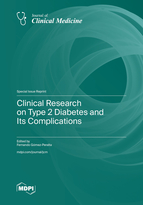Clinical Research on Type 2 Diabetes and Its Complications
A special issue of Journal of Clinical Medicine (ISSN 2077-0383). This special issue belongs to the section "Endocrinology & Metabolism".
Deadline for manuscript submissions: closed (15 October 2022) | Viewed by 55047
Special Issue Editor
Interests: epidemiology of diabetes and complications; clinical therapeutics of diabetes; continuous glucose monitoring; diabetes telemedicine; diabetes smart pens/caps; diabetes drug/insulin development/clinical trials; hypoglycaemia in diabetes; sleep disorders and diabetes
Special Issues, Collections and Topics in MDPI journals
Special Issue Information
Dear Colleagues,
I have the honour of being the Guest Editor of a new Special Issue for the Journal of Clinical Medicine, titled “Clinical Research on Type 2 Diabetes and Its Complications”.
This Special Issue will bring together exciting papers focused on clinically relevant research on type 2 diabetes and its complications, ideally offering a sound overview of the most interesting topics in the field. The Issue should be an attractive condensed reading for physicians interested in a general view of diabetes, including primary care, internal medicine, and geriatric medicine.
Manuscripts describing clinical research on type 2 diabetes, including original research, reviews, or mini-reviews, will be welcome. Research and data from a global and multiethnic source will be appreciated. The roles of new technologies in the detection, management, and prediction of diabetic complications are also of interest. We aim to present an updated view on the current incidence, prevalence, and disease burden caused by diabetes complications.
Many thanks in advance.
Dr. Fernando Gómez-Peralta
Guest Editor
Manuscript Submission Information
Manuscripts should be submitted online at www.mdpi.com by registering and logging in to this website. Once you are registered, click here to go to the submission form. Manuscripts can be submitted until the deadline. All submissions that pass pre-check are peer-reviewed. Accepted papers will be published continuously in the journal (as soon as accepted) and will be listed together on the special issue website. Research articles, review articles as well as short communications are invited. For planned papers, a title and short abstract (about 100 words) can be sent to the Editorial Office for announcement on this website.
Submitted manuscripts should not have been published previously, nor be under consideration for publication elsewhere (except conference proceedings papers). All manuscripts are thoroughly refereed through a single-blind peer-review process. A guide for authors and other relevant information for submission of manuscripts is available on the Instructions for Authors page. Journal of Clinical Medicine is an international peer-reviewed open access semimonthly journal published by MDPI.
Please visit the Instructions for Authors page before submitting a manuscript. The Article Processing Charge (APC) for publication in this open access journal is 2600 CHF (Swiss Francs). Submitted papers should be well formatted and use good English. Authors may use MDPI's English editing service prior to publication or during author revisions.
Keywords
- Type 2 diabetes
- Diabetes complications
- Diabetes clinical research
- Diabetes treatment
- Continuous glucose monitoring
- Prevalence
- Incidence







